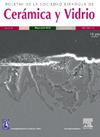Colloidal approach to fabricate high-loaded feedstocks for material extrusion of dense sintered Al2O3 structures for biomedical applications
IF 2.7
4区 材料科学
Q1 MATERIALS SCIENCE, CERAMICS
Boletin de la Sociedad Espanola de Ceramica y Vidrio
Pub Date : 2025-03-01
DOI:10.1016/j.bsecv.2025.01.004
引用次数: 0
Abstract
Fused filament fabrication (FFF) is one of the most competitive additive manufacturing technologies which allow easy component customization for several sectors. Its application to the ceramic field is rapidly growing addressed by formulating high-loading composites in several binder systems which after the printing process, they are removed by a two-step debinding process. In this work, new granules and filaments of Al2O3 have been produced using a two-component binder system, consisting of polylactic acid (PLA) and polycaprolactone (PCL). Al2O3 feedstock is printed by FFF obtaining complex 3D structures and after a thermal one-step debinding and sintering cycle 100% Al2O3 components is obtained with a relative density of 96%.
The mixing process is based on a colloidal route where the ceramic particle surface modification improves its interaction with the binder. This improvement brings the possibility to increase the ceramic load in the composite up to 48 vol.%. Oscillatory melting rheology was measured to simulate the printing process. The incorporation of 25 vol.% PCL in binder is enough to modify the flow of the melt composite, enlarging the plastic solid-like flow where the Al2O3 composites are suitable to flow through the nozzle, and build adequate 3D structures using high-loaded feedstocks.
采用胶体方法制造高负荷原料,用于挤压致密烧结 Al2O3 结构的材料,以满足生物医学应用需求
熔丝制造(FFF)是最具竞争力的增材制造技术之一,它允许多个部门轻松定制组件。它在陶瓷领域的应用正在迅速增长,通过在几种粘合剂系统中配制高负荷复合材料,在印刷过程后,通过两步脱脂过程将其去除。在这项工作中,使用由聚乳酸(PLA)和聚己内酯(PCL)组成的双组分粘合剂体系制备了新的Al2O3颗粒和长丝。Al2O3原料通过FFF打印得到复杂的3D结构,经过一步热脱脂和烧结循环,获得100%的Al2O3组分,相对密度为96%。混合过程基于胶体路线,其中陶瓷颗粒表面改性改善了其与粘合剂的相互作用。这一改进使复合材料中的陶瓷载荷增加到48vol .%成为可能。通过测量振荡熔融流变学来模拟印刷过程。在粘合剂中掺入25vol .%的PCL足以改变熔体复合材料的流动,扩大Al2O3复合材料适合流过喷嘴的塑料固体状流动,并使用高负荷的原料建立足够的3D结构。
本文章由计算机程序翻译,如有差异,请以英文原文为准。
求助全文
约1分钟内获得全文
求助全文
来源期刊

Boletin de la Sociedad Espanola de Ceramica y Vidrio
工程技术-材料科学:硅酸盐
CiteScore
5.50
自引率
2.90%
发文量
72
审稿时长
103 days
期刊介绍:
The Journal of the Spanish Ceramic and Glass Society publishes scientific articles and communications describing original research and reviews relating to ceramic materials and glasses. The main interests are on novel generic science and technology establishing the relationships between synthesis, processing microstructure and properties of materials. Papers may deal with ceramics and glasses included in any of the conventional categories: structural, functional, traditional, composites and cultural heritage. The main objective of the Journal of the Spanish Ceramic and Glass Society is to sustain a high standard research quality by means of appropriate reviewing procedures.
 求助内容:
求助内容: 应助结果提醒方式:
应助结果提醒方式:


